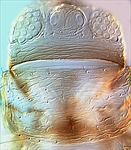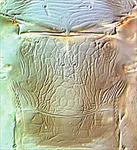
Head & pronotum

Mesonotum & metanotum (phase contrast image)

Mesonotum & metanotum (Differential Interference image)
Bailey (1957: 190) stated that P. priesneri is known only from the original specimens, and also indicated that this species is "extremely close" to P. pardalotus. However, O'Neill (1960) provided a redescription and illustrated key to distinguish the two species. She pointed out that the metanotum of P. priesneri is reticulate with internal markings, and lacks the distinctive swirling concentric sculpture lines on the posterior half that are typical of P. pardalotus (Minaei & Mound, 2015).
The genus Psilothrips includes five species, three from the Mediterranean region between the Canary Islands and India, and two from western USA (Minaei & Mound, 2015). These species are unusual in having a pair of long setae medially on each tergite that arise from the antecostal ridge.
Females have been studied from five different arid zone plant species in various families, but the breeding host is possibly Amaranthus [Amaranthaceae], or Atriplex [Chenopodiaceae].
Recorded from California, Arizona and Texas.
THRIPIDAE - THRIPINAE
Psilothrips priesneri (Moulton)
Anaphothrips priesneri Moulton, 1926: 123
Minaei K & Mound LA (2015) Thysanoptera disjunct distribution between western America and the Mediterranean with a new Psilothrips species (Thripidae) from Iran. Deutsche Entomologische Zeitschrift 62 (1): 1–7.